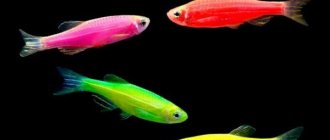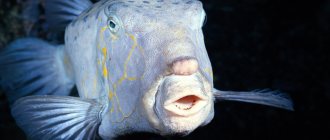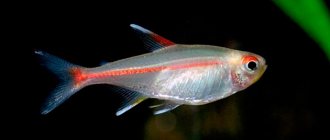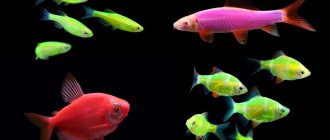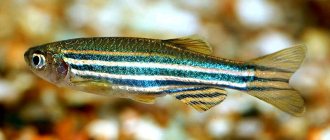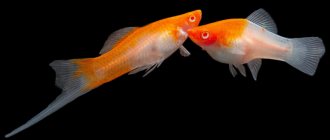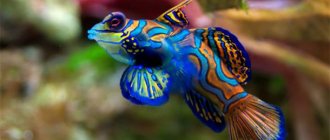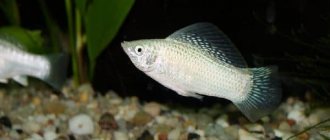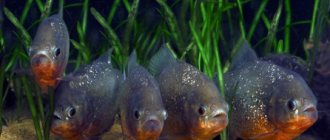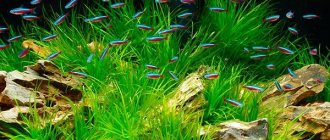Reviews of fluorescent fish
Marina, review of the “Blackberry” thorn with a stripe
Unpretentious, beautiful aquarium fish
Sergey Ivanov, review of fluorescent zebrafish
Very active, nimble fish, always on the move, need a spacious living space, swim even when sleeping, and are not shy. In my 200 liters, the liters run after each other throughout the entire aquarium all day long.
I didn’t see any drawbacks, except that when feeding, due to the activity of zebrafish, some small timid fish may be afraid to swim up to the feeder.
These maintenance recommendations are completely unsuitable for these fish: ...A pair can be kept even in a 3-liter jar, but it is better to provide a flock of 10-15 individuals with an elongated container with a volume of at least 30 liters...
Such active fish must be kept in an aquarium of at least a meter so that they have the opportunity to accelerate and swim quickly. A friend of mine has zebrafish that live in a 60-liter aquarium; they swim slowly and have no way to accelerate. In a 3-liter jar they will stand still.
Katya, review of the fluorescent zebrafish
A very smart and nimble fish with interesting behavior. Hardy and unpretentious. It's very inexpensive.
It can be aggressive on a territorial basis in small containers both to relatives and to other species, and even to larger ones.
Danio lived at my work in a 25 liter aquarium for 4 years. The specimen was strange, with a veil shape and a long lower jaw, in general, a complete mutant Tyrannized catfish and bullied the neons.
The specimen was strange, with a veil shape and a long lower jaw, in general, a complete mutant Tyrannized catfish and bullied the neons. But it was my favorite fish. I want one more.
But it was my favorite fish. I want one more.
GLOFISH, bright luminous fish, fluorescent fish, GloFish
We are pleased to introduce GloFish® fluorescent fish that are a vibrant addition to any home, office or classroom, where their stunning color and unmatched beauty quickly become the talk of the town. They will become a favorite pet from the moment they move into your aquarium! GLOFISH glow in the dark due to genetic modification - inserting part of the jellyfish gene into the zebrafish gene, which allows this fish to glow in the dark when illuminated with blue light.
GLOFISH GloFish is a patented commercial brand of GloFish, under which genetically modified fluorescent fish are sold. At first it was zebrafish – a species of popular and unpretentious aquarium fish of the carp family. A distinctive feature of GloFish individuals artificially bred by genetic modification from the original form is a red, green or orange fluorescent coloring, which becomes more noticeable and intense under ultraviolet light. Although the fish were not originally bred as ornamental fish, they became the first publicly available genetically modified pet.
FEATURES The transgenic form prefers warmer water - about 28 degrees. No differences in the maintenance, feeding or development of genetically modified fish have been observed. Transgenic fish are also easy to keep and peaceful.
Video about GloFish fish of foreign colleagues:
HISTORY The natural zebrafish from which GloFish was grown is native to rivers in India and Bangladesh. It measures about three centimeters in length and has gold and blue stripes along its body.
In 1999, Dr Zhiyuan Gong and his colleagues at the National University of Singapore worked with the green fluorescent protein (GFP) gene, which nature has endowed only with some Pacific jellyfish. This gene is responsible for the synthesis of a phosphor protein, which emits rays of a pleasant greenish color in the dark. They inserted this gene into the zebrafish embryo, which allowed them to create a genome that gave the fish a bright fluorescent color, both from natural white light and from ultraviolet radiation.The genetic engineers' initial goal was to make it easier to observe the internal organs of these translucent fish. But a photograph of a fish glowing with a greenish ghostly light, shown at a scientific conference, was seen by a representative of a company that breeds and sells aquarium fish. At the request of the company, a red glow gene isolated from sea coral was added to the zebrafish genome. The resulting breed was named “Night Pearl”.
In the United States, glowing zebrafish were originally obtained for the purpose of creating living indicators of pollution: in the presence of certain toxic substances in the water, the fish were supposed to change color. But in 2003, businessmen and scientists entered into a contract under which the first genetically modified fish, GloFish, appeared on the market. In addition to the red fluorescent zebrafish sold under the brand name Starfire Red, green and orange-yellow fluorescent zebrafish were released by mid-2006, followed by blue and purple ones in 2011. These genetic lines of fish were given the trade names "Electric Green" and "Galactic Purple". All of these fish were genetically engineered using recombinant DNA from various sea corals.
In 2012, a new variety of fluorescent aquarium fish appeared under the brand name of the green variety “Electric Green” GloFish, which were bred using the same method as the previous ones, but instead of zebrafish, common ternets (lat. Gymnocorymbus ternetzi) were used. In 2015, green glowing Sumatran barbs (lat. Puntius tetrazona) were introduced.
Despite the widespread opinion about the sterility or sterilization of genetically modified fish in order to prevent them from spreading in natural bodies of water, completely healthy and viable offspring can be obtained from GloFish.
In 2021, GloFish zebrafish, barbs, thornets - Moscow bred, the color of which is persistent, bright and practically indistinguishable from foreign photographs of GloFish, went on sale on the aquarium market in Moscow and then throughout Russia. According to the breeders of luminous fish, they are no different in content and reproduction from natural forms. The cost of glo-fish on the Moscow market is significantly lower than foreign ones. Since 2015, Glo products have also appeared on the market, entire aquariums with actinic lamps; such aquariums can be located in a dark room and serve as a night light with live fluorescent fish and luminous decorations, bubbles and soil.
Opinion of the aquarium fish store “Fish at Home”: “In the coming year, the cost of GloFish will definitely be the same as the usual colors of its aquarium relatives, we expect an increase in the number of entrepreneurs with aquarium farms engaged in breeding GloFish, which will lead to saturation of the market with bright fish. In fact, this is a breakthrough in decorative aquariums, since there have never been such bright and saturated colors, and there is an assumption that the classic colors of aquarium fish are shifting towards the bright colors of Glo!. We think 2016 can be safely called the year of birth of the new aquarium style “Glo Aquarium”
Deliver glofish via online store
Buy glofish, come to the store
general description
Neons are small schooling fish, the length of which does not exceed 4-5 cm. They have an elongated body, slightly flattened on the sides, a small mouth and transparent fins. Moreover, the dorsal one is shorter than the anal one.
Like other members of the characin family, neons have an additional fin. It is located immediately behind the spinal cord and consists exclusively of adipose tissue. The body of each fish is decorated with a longitudinal reflective strip, creating a glowing effect.
It consists of special cells - chromatophores - hidden under the scales.
Features of creating conditions for a comfortable life
Glowing fish are quite small in size, so they do not need large volumes of water. They are equally comfortable in a large aquarium, in a medium-sized tank, and even in a small jar. The main thing is that the fish do not feel crowded in the prepared container. Therefore, when choosing an aquarium, you need to focus on how many individuals will live in it.
The bottom can be sandy or unpaved; fish do not have any particular preferences in this matter. But you need to monitor the water temperature so that the aquarium inhabitants feel comfortable and do not get sick. In addition, it is worth paying attention to such water parameters as the degree of hardness and acidity. Recommended characteristics of water in the aquarium:
- temperature range – within +28° – +29°C;
- acidity index – from 6 to 7.5;
- hardness – about 10°.
Like any other aquarium inhabitant, luminous fish need shelters, the function of which is performed by driftwood and grottoes, and decorations - castles and jugs. There should also be plants in the aquarium. Since the fish do not show any interest in plant aquatic crops, there is no need to be afraid that they will tear them out of the ground with their noses.
The water must be clean, so at least 1/3 of the total volume needs to be changed every week.
Lighting and backlighting
Fluorescent fish will not shine when exposed to regular lamps. To admire the shine and different colors emanating from these fish, illumination must be done using blue and ultraviolet lamps. Aquarists who want to maximize the glow and color of their fish will have to pay a lot of money to purchase special lights designed specifically to illuminate aquariums containing these unusual fish.
Feeding rules
Glowing fish are not picky eaters. However, in order for them to feel comfortable, enjoy the glow and not get sick, the diet should be varied. The menu should include:
- Dry food is a specialized industrial food.
- Products of plant origin, mainly green vegetables - zucchini and cucumbers. It is recommended to give them to the fish periodically so that the pets receive a sufficient amount of vitamins and minerals.
- Live food - coretras, daphnia (but only small ones and bloodworms).
Fish should not be overfed.
Feeding is carried out 2 times during the day.
It is recommended to remove the remaining food from the water 10 minutes after the start of feeding; this will help keep the tank clean longer. Once every few weeks you can have a fasting day.
Not just zebrafish
Further experiments carried out on unpretentious zebrafish made it possible to create their blue and purple genetically modified relatives.
The next fish to glow in the dark were larger creatures - thornets. Over the course of several years, more than five colors of these funny round “lanterns” were developed. Following them came the turn of pugnacious barbs, more picky about the conditions of aquarium keeping.
By this time, many aquarists fell in love with bright fish, and the GloFish company began to develop and produce new decorations that help make the small underwater world more colorful.
The names of the luminous fish were also beautiful and memorable: Starfire Red (red star fish), Sunburst Orange (orange ray) or Galactic Purple (purple of the galaxy).
Content and Compatibility
The three species of modified glowing fish are schooling. Once alone, species such as zebrafish and ternets become lethargic, lose their appetite, and may even die.
Therefore, it is better to house pets in small schools, 6-8 fish of each variety. Moreover, the difference in color does not affect the comfortable coexistence of the fish.
You should not place small luminous specimens and larger predators in the same aquarium. For example, cichlids are always ready to hunt for visible colored lights.
As luminescent fish age, their color becomes brighter and more saturated. When reproduced under artificial conditions, babies inherit the coloration of their parents.
In nature, the color and body shape of females and males differ, so determining the sex of a fish is not difficult even for an inexperienced aquarist. For GloFish specimens everything is more complicated. The artificially added color is the same in both sexes. It is still possible to distinguish - females have a more rounded abdomen.
How to set up an aquarium?
The demand for luminous fish is constantly increasing. Therefore, specifically in order to highlight their unusualness, manufacturers offer a lot of decorative ornaments. These are bright artificial plants, soil of unusual shades, even containers with neon lighting.
However, experienced aquarists do not advise getting too carried away with such decorations; in such an aquarium, luminous fish can simply get lost.
Multi-colored pets look very beautiful against a background of light soil, preferably snow-white sand and a dark background. The rich greenery of underwater plants also sets off well the unusual “illuminations” of individuals. Of course, these fish are very unpretentious, but they will appreciate natural plants and good nutrition.
The only additional thing that the owner of new species will need is special aquarium lamps. Under normal lighting, the bodies of the fish do not glow; all the beauty is revealed by lamps with ultraviolet radiation.
Not just experiments with genes
Long before the creation of luminous fish with a modified genome, a small pet shone in home aquariums - blue neon. This tiny beauty was first discovered in the waters of a tropical river in South America back in 1935. Since then, these firefish have firmly established themselves in home aquariums. But not all of the neon glows; a bright fluorescent blue stripe runs along its body.
There are also red varieties that are somewhat larger and have a more pronounced burning line. But they are less popular among aquarists because they are difficult to breed.
In addition to neons, there are several other types of aquarium fish that can glow under certain lighting. These are the lanternfly tetra, cardinal and gracilis. The latter has an almost transparent body, along which a bright red luminous strip stretches.
Unusual angelfish
The first successful experiments on changing the genome of fish were carried out on small schooling species, characterized by active and successful reproduction. Therefore, after just a few years, new generations of luminous fish successfully passed on the altered DNA to their descendants.
Things got more complicated when scientists decided to change the gene structure of one of the species of aquarium cichlids. These majestic fish with high sail-like fins have long been a fixture in the homes of many lovers of the underwater world.
Keeping angelfish does not require special water or temperature parameters, and they spawn quite willingly, so scientists decided to continue the experiment on them. And we encountered some minor difficulties. These large fish release a very small volume of eggs during spawning (compared to the same zebrafish) and the process of maintaining and transmitting the altered genome was slow. But in the end, science defeated nature and a new species of luminous individuals successfully appeared on the market.
Fluorescent aquarium favorites
There are many fish that have been genetically modified to glow. But the most famous and widespread are neons and gracilis, which differ from other luminous fish in that their glow is not the result of the work of scientists, but a natural gift.
Neons
Blue neon is unique in that its glow is not the work of biologists and geneticists, but a gift presented by nature itself. Its natural habitat is the Amazon. This species was first discovered and described in 1935 by the French crocodile hunter Auguste Rabot.
The story of the discovery of blue neon is interesting - while hunting crocodiles in the tributaries of the Amazon, Auguste Rabeau caught tropical fever. For many hours the Frenchman lay on the shore, on the verge of death. However, when the body was finally able to defeat the disease, and Auguste woke up, he was tormented by severe thirst, which he was able to quench by scooping up river water. In his palm with water, he came across a small fish shining with blue light.
This is how the resident of the Amazonian tributaries ended up in most aquariums around the world over time. This fish has an unusual, memorable color, which makes it impossible to confuse it with other aquarium inhabitants. A distinctive feature of neon is the presence of a blue stripe on the body, which starts from the eye, reaches the tail and ends smoothly. The color of the abdomen is white, the fins are transparent, the dorsal fin has a white frame with a milky tint.
Neons are unpretentious fish, they are easy to care for, they do not require the creation of difficult conditions for a comfortable existence. But still, certain water parameters will have to be maintained for them.
The important thing is the water temperature, which should be in the range from +18° to +23°C.
Neons do not need large tanks. Depending on the number of individuals in the flock and the presence of aquarium neighbors, the required size of the aquarium is selected. The only difficulty an aquarist may encounter is breeding neons. The fact is that their spawning is quite difficult, and during the laying of eggs a couple of fish need to be moved into a separate container with a volume of at least 10 liters.
In 1956, another type of neon was discovered - fish that inhabit shallow reservoirs in South America. In addition to their red color, these neons differ from their blue counterparts in that they grow up to 5 cm, and they have a stripe of bright, rich color running down their body.
Neons' diet should be varied and include live and plant food, industrial dry rations. The character of neons is very simple and flexible. These fish are calm and peaceful; they will not conflict with their relatives or with other aquarium inhabitants.
Other natural fluorescent fish
Neons aren't the only aquarium inhabitants that can glow in a variety of colors. This category also includes:
- Tetra flashlight
This is a fish native to the Amazon River basin. The “flashlight” received its name due to its unusual, original color - at the end of the caudal fin there is a golden spot, another red spot is located on the top of the head, above the eye. - Costello or green neon
Costello shines with a soft green color with an olive tint. This radiance comes from the upper part of the body, which is colored bright green. But the lower part of the fish’s body is faded and completely unremarkable, painted in a light silver tone. - Cardinal
The cardinal has other names: “false” neon, magnificent minnow, Chinese zebrafish.
GloFish Project
Just a few years later, in 2003, zebrafish were bred that fluoresced with scarlet and yellow light. Scientists were able to achieve this by “installing” a sea coral gene responsible for red radiation into them. And successful experiments with the DNA of jellyfish and corals gave the world orange luminous fish.
Anticipating the commercial success of these researches, scientists and business representatives entered into a contract and created a new trademark - GloFish (from glow - “glowing, shining” and fish - “fish”). The company is managed in Hong Kong, and the unusual luminous fish, which have become in great demand, have settled in many aquariums.
Fish care
Despite the external unusualness, caring for such modified pets will not tire the owner. The changes have hardly affected the behavior and habits of the fish; they can be fed with regular food and kept together with the usual inhabitants of aquariums.
Due to the fact that the gene of tropical organisms has been introduced into the fish’s body, they prefer warmer water, 28-29° C.
You can feed both dry and frozen food (bloodworm, brine shrimp, daphnia). As with ordinary fish, it is better not to overfeed luminous fish and change the water in the aquarium every two weeks. It is desirable to have living plants in which pets can hide.
